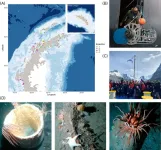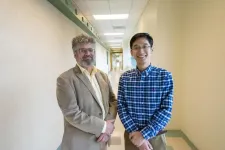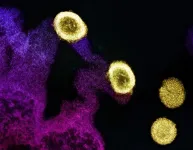(Press-News.org) Since more than a decade it has been possible for physicists to accurately measure the location of individual atoms to a precision of smaller than one thousandth of a millimeter using a special type of microscope. However, this method has so far only provided the x and y coordinates. Information on the vertical position of the atom – i.e., the distance between the atom and the microscope objective – is lacking. A new method has now been developed that can determine all three spatial coordinates of an atom with one single image. This method – developed by the University of Bonn and University of Bristol – is based on an ingenious physical principle. The study was recently published in the specialist journal Physical Review A.
Anyone who has used a microscope in a biology class to study a plant cell will probably be able to recall a similar situation. It is easy to tell that a certain chloroplast is located above and to the right of the nucleus. But are both of them located on the same plane? Once you adjust the focus on the microscope, however, you see that the image of the nucleus becomes sharper while the image of the chloroplast blurs. One of them must be a little higher and one a little lower than the other. However, this method cannot give us precise details about their vertical positions.
The principle is very similar if you want to observe individual atoms instead of cells. So-called quantum gas microscopy can be used for this purpose. It allows you to straightforwardly determine the x and y coordinates of an atom. However, it is much more difficult to measure its z coordinate, i.e., the distance to the objective lens: In order to find out on what plane the atom is located, multiple images must be taken in which the focus is shifted across various different planes. This is a complex and time-consuming process.
Turning round specks into dumbbells
“We have now developed a method in which this process can be completed in one step,” explains Tangi Legrand from the Institute of Applied Physics (IAP) at the University of Bonn. “To achieve this, we use an effect that has already been known in theory since the 1990s but which had not yet been used in a quantum gas microscope.”
To experiment on the atoms, it is first necessary to cool them down significantly so that they are barely moving. Afterwards, it is possible, for example, to trap them in a standing wave of laser light. They then slip into the troughs of the wave similar to how eggs sit in an egg box. Once trapped, to reveal their position, they are exposed to an additional laser beam, which stimulates them to emit light. The resulting fluorescence shows up in the quantum gas microscope as a slightly blurred, round speck.
“We have now developed a special method to deform the wavefront of the light being emitted by the atom,” explains Dr. Andrea Alberti. The researcher, who has now moved from the IAP to the Max Planck Institute of Quantum Optics in Garching, also participated in the study. “Instead of the typical round specks, the deformed wavefront produces a dumbbell shape on the camera that rotates around itself. The direction in which this dumbbell points is dependent on the distance that the light had to travel from the atom to the camera.”
“The dumbbell thus acts a bit like the needle on a compass, allowing us to read off the z coordinate according to its orientation,” says Prof. Dr. Dieter Meschede. The IAP researcher, whose research group carried out the study, is also a member of the transdisciplinary research area “Matter” at the University of Bonn.
Important for quantum mechanics experiments
The new method makes it possible to precisely determine the position of an atom in three dimensions with one single image. This is important, for example, if you want to carry out quantum mechanics experiments with atoms because it is often essential to be able to precisely control or track their position. This allows researchers to make the atoms interact with one another in the desired way.
Furthermore, the method could also be used to help develop new quantum materials with special characteristics. “For example, we could investigate which quantum mechanical effects occur when atoms are arranged in a certain order,” explains Dr. Carrie Weidner from the University of Bristol. “This would allow us to simulate the properties of three-dimensional materials to some extent without having to synthesize them.”
Participating institutes and funding:
The University of Bonn and the University of Bristol both participated in the study. The research was financed by the German Research Foundation (DFG).
Publication: Tangi Legrand, Falk-Richard Winkelmann, Wolfgang Alt, Dieter Meschede, Andrea Alberti and Carrie A. Weidner: Three-dimensional imaging of single atoms in an optical lattice via helical point-spread-function engineering. Phys Rev A, DOI: 10.1103/PhysRevA.109.033304; URL: https://link.aps.org/doi/10.1103/PhysRevA.109.033304
Media contact:
Tangi Legrand
Nonlinear Quantum Optics Group at the University of Bonn
Tel. +49 228 73-9320
E-mail: legrand@uni-bonn.de
END
New method measures the 3D position of individual atoms
The method developed at the Universities of Bonn and Bristol uses an ingenious physical principle
2024-03-05
ELSE PRESS RELEASES FROM THIS DATE:
Cleveland Clinic-led research supports repurposing sildenafil (Viagra) for Alzheimer’s treatment
2024-03-05
CLEVELAND – New Cleveland Clinic-led research points to sildenafil (Viagra) as a potential treatment for Alzheimer’s disease. The study provides evidence from computational models, insurance claims data and observations from brain cells in Alzheimer’s patients.
Sildenafil is the main component of drugs used to treat erectile dysfunction (Viagra) and pulmonary arterial hypertension (Revatio).
“Our findings provide further weight to re-purposing this existing FDA-approved drug as a novel treatment for Alzheimer’s, which is in great need of new therapies,” ...
Antarctic researchers hitched a lift on a cruise ship, and recommend this eco-friendly, collaborative approach to remote ocean science
2024-03-05
Antarctic researchers hitched a lift on a cruise ship, and recommend this eco-friendly, collaborative approach to remote ocean science.
####
Article URL: https://journals.plos.org/climate/article?id=10.1371/journal.pclm.0000348
Article Title: New methods of undertaking marine science in Antarctica using tourism vessels
Contact: Matthew Mulrennan; matt@kolossal.org
Author Countries: Canada, United States
Funding: The authors received no specific funding for this work. END ...
Odysseus has a new home and brings the Earthling Project along for the ride
2024-03-05
March 5, 2024, Mountain View, CA – The moon lander Odysseus, known as Odie, touched down on the Moon's surface on February 22, becoming the first time the U.S. has landed on the Moon in more than 50 years and the first commercial moon lander to successfully land on the Moon. Along with its science payload, the spacecraft also brought along a fusion of art and space exploration, SETI Institute's Artist in Residence (SETI AIR), Felipe Pérez Santiago's Earthling Project, a collection of global musical compositions representing Earth's cultural ...
Painting a molecular portrait of the brain with mass spectrometry and deep learning
2024-03-05
Beckman Institute for Advanced Science and Technology researchers Jonathan Sweedler, a professor of chemistry, and Fan Lam, a professor of bioengineering, outlined how spatial omics technologies can reveal the molecular intricacy of the brain at different scales.
Their research appeared this month in Nature Methods.
The researchers and their colleagues used a biochemical imaging framework integrated with deep learning to create 3D molecular maps with cell specificity to better understand how the brain functions in health and disease. Their research is supported by a $3 million grant from ...
Semaglutide reduces severity of common liver disease in people with HIV
2024-03-05
WHAT:
A weekly injection of semaglutide was safe and reduced the amount of fat in the liver by 31% in people with HIV and metabolic dysfunction-associated steatotic liver disease (MASLD), according to a presentation today at the 2024 Conference on Retroviruses and Opportunistic Infections (CROI) in Denver. This is the first clinical trial of semaglutide for MASLD in people with HIV. The research was sponsored by the National Institute of Allergy and Infectious Diseases (NIAID), part of the National Institutes of Health, and conducted in the United States and Brazil by ACTG, a global clinical trials network focused on HIV and other infectious diseases. ...
The Lancet: Experts warn about the overmedicalisation of menopause and call for a new approach to how society views menopause and supports women as they age
2024-03-05
The Lancet: Experts warn about the overmedicalisation of menopause and call for a new approach to how society views menopause and supports women as they age
Menopause is a life stage for half the world’s population and is generally depicted in a negative way. However, women’s experiences of menopause are unique and vary hugely.
The Lancet 2024 Series on menopause argues that an over-simplified narrative of menopause as a health problem to be solved by replacing hormones is not based on evidence and deflects attention from the need for substantial societal shifts in how menopause, and midlife/older women in general, are viewed and treated around the world.
The ...
Researchers show that menopause does not always impact mental health
2024-03-05
A new review paper from authors at Brigham and Women’s Hospital and collaborators concludes that menopause does not uniformly elevate the risk of depression and other mental health conditions.
Menopause has long been thought to cause psychological distress, but a new review suggests that this is not always the case. The review, written by experts from Brigham Women’s Hospital, a founding member of the Mass General Brigham healthcare system, and international collaborators, is the third in a series of menopause-themed papers published in The ...
Evolving hydrogen-storage technology: guidelines developed for the design of anti-evaporation catalysts
2024-03-05
1. A research team consisting of NIMS and the Tokyo Institute of Technology has identified materials capable of catalyzing the conversion of ortho-hydrogen to para-hydrogen. These catalysts should be essential to the spread of mass-transportation/storage of liquid hydrogen.
2. Hydrogen is becoming widely accepted as an alternative energy source to fossil fuels. Its liquefaction (at temperatures below -253°C under pressures higher than one atmosphere) can dramatically reduce its volume, making it suitable for transportation and storage. Hydrogen molecules (H2)—each composed of two hydrogen atoms—exist in two isomeric forms: ortho- and para-H2. Under normal conditions, ...
Early retirement impacts mental health of blue-collar women more than white-collar peers
2024-03-05
Retirement is a major transition that can have a significant impact on a person’s life.
For some, retirement evokes thoughts of slowing down, relaxing, and enjoying more of what life has to offer. For others, ending a regular work schedule can create stress and uncertainties about being able to pay necessary bills and maintain adequate medical care.
A new study by researchers at the Yale School of Public Health examines how retirement affects mental health and related inpatient mental health care among female workers in China, ...
A smart molecule beats the mutation behind most pancreatic cancer
2024-03-05
FOR IMMEDIATE RELEASE
Media Contact: LEVI GADYE (628) 399-1046
Levi.Gadye@ucsf.edu
Subscribe to UCSF News
A Smart Molecule Beats the Mutation Behind Most Pancreatic Cancer
Scientists discover a new way to disarm a deadly protein that also appears in cancers of the lung, breast and colon.
UC San Francisco researchers have designed a candidate drug that could help make pancreatic cancer, which is almost always fatal, a treatable, perhaps even curable, condition.
The new molecule permanently modifies a wily cancer-causing ...
LAST 30 PRESS RELEASES:
Decoupling the HOR enhancement on PtRu: Dynamically matching interfacial water to reaction coordinates
Sulfur isn’t poisonous when it synergistically acts with phosphine in olefins hydroformylation
URI researchers uncover molecular mechanisms behind speciation in corals
Chitin based carbon aerogel offers a cleaner way to store thermal energy
Tracing hidden sources of nitrate pollution in rapidly changing rural urban landscapes
Viruses on plastic pollution may quietly accelerate the spread of antibiotic resistance
Three UH Rainbow Babies & Children’s faculty elected to prestigious American Pediatric Society
Tunnel resilience models unveiled to aid post-earthquake recovery
Satellite communication systems: the future of 5G/6G connectivity
Space computing power networks: a new frontier for satellite technologies
Experiments advance potential of protein that makes hydrogen sulfide as a therapeutic target for Alzheimer’s disease
Examining private equity’s role in fertility care
Current Molecular Pharmacology achieves a landmark: real-time CiteScore advances to 7.2
Skeletal muscle epigenetic clocks developed using postmortem tissue from an Asian population
Estimating unemployment rates with social media data
Climate policies can backfire by eroding “green” values, study finds
Too much screen time too soon? A*STAR study links infant screen exposure to brain changes and teen anxiety
Global psychiatry mourns Professor Dan Stein, visionary who transformed mental health science across Africa and beyond
KIST develops eco-friendly palladium recovery technology to safeguard resource security
Statins significantly reduce mortality risk for adults with diabetes, regardless of cardiovascular risk
Brain immune cells may drive more damage in females than males with Alzheimer’s
Evidence-based recommendations empower clinicians to manage epilepsy in pregnancy
Fungus turns bark beetles’ defenses against them
There are new antivirals being tested for herpesviruses. Scientists now know how they work
CDI scientist, colleagues author review of global burden of fungus Candida auris
How does stroke influence speech comprehension?
B cells transiently unlock their plasticity, risking lymphoma development
Advanced AI dodel predicts spoken language outcomes in deaf children after cochlear implants
Multimodal imaging-based cerebral blood flow prediction model development in simulated microgravity
Accelerated streaming subgraph matching framework is faster, more robust, and scalable
[Press-News.org] New method measures the 3D position of individual atomsThe method developed at the Universities of Bonn and Bristol uses an ingenious physical principle








